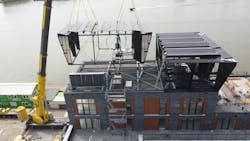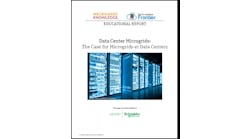Solar panels and batteries are common elements of a microgrid. Wind turbines, on the other hand, are more of a rarity.
Large wind turbines can be found in microgrids built on islands or in remote blustery locales. But smaller rooftop wind turbines, befitting a city skyline, are rare. Solar panels are the more common sight.
Cities can be plenty windy. So what’s the problem?
Rooftop wind turbines placed on buildings are inefficient because they are in “the shadow of the winds,” said Alexander Suma, founder and CEO of IBIS Power, a renewable energy company in the Netherlands. Turbulence around the rooftop makes energy production inefficient.
His company has devised a system called PowerNest — a modular unit that combines solar, wind and energy management in an architecture that Suma said overcomes the turbulence problem and maximizes renewable energy production.
1 + 1 =3
“The goal is to generate as much energy as possible on the limited roof space because big buildings, high buildings, they are basically the biggest energy users inside a city grid. On a small footprint, they have the highest demand,” Suma said in a recent interview with Microgrid Knowledge.
Designed for flat roofs, PowerNest requires that the building be at least five stories, a height where the best winds begin. The unit has internal wind turbines and solar panels on the top. It is placed on the building roof.
It looks like a simple box from the outside, but its success lies in its use of aerodynamic shaping, he said. “Imagine an airplane with square wings. It wouldn’t take off. The wings look very simple, but there is a lot of intelligence behind that shape.”
PowerNest works to remove the turbulence around a building by capturing the wind, then bending it inward, accelerating it and guiding it through the wind turbine.
The wind/solar combination is important, Suma said, because solar alone often can’t meet the building’s energy demand — there is not enough roof space. Plus, solar generates less energy in northern climates during the winter. The wind also cools the solar panels. The unit uses bifacial solar panels and employs internal solar reflections.
All of this leads to renewable energy generation that is multiple times the norm from rooftop renewables, especially in cities with good wind and solar climates, according to Suma.
“It’s not just solar and wind stuck together,” said Timothy Vail, founder and principal at Blue Mountain Technologies and contract consultant with IBIS Power. “The word synergism really comes to mind because the louvers on the PowerNest not only direct the airflow and optimize the vertical axis wind turbines, but it also cools the solar panels that are overhead. And so it takes double advantage of that situation. And it really is the first and only time I’ve seen two distinct technologies put together and not just be one plus one. This is one plus one equals three.”
PowerNest moving into US market
Founded in 2012, IBIS Power installed its first commercial unit in Europe in 2019 and is now completing its fifth installation with eight more in the works in the Netherlands and Belgium. The company is currently eyeing medium- to high-rise buildings in the US, attracted by the nation’s growing push for local energy, electrification and decarbonization of urban buildings. Suma said he’s initially focusing on Boston, New York and Philadelphia, where he sees strong interest in sustainability, good wind and solar potential and building stock of the right size and density. Electricity costs are also high in these cities, which makes energy alternatives more cost-competitive.
The PowerNest is not a microgrid, in and of itself, but is microgrid ready — able to connect to pair with a microgrid controller and serve as a component of a building nanogrid.
Others pursuing small wind for microgrids
IBIS Power isn’t the only company that sees potential in pairing small wind turbines and microgrids.
Bergey Wind, a long-time small wind turbine producer, has touted their use in off-grid hybrid microgrids as a way to reduce the use of diesel, increase renewables and spare wear and tear on batteries.
Newer to the market, California-based Air Voltaics is pushing small to midsize wind turbines for microgrids for similar reasons. The company also points out that wind turbines demand less space than solar panels. Together with solar panels, they create more reliable energy supply.
Last year, FlowGen, a wind turbine technology company based in Switzerland, and microgrid developer CleanSpark inked a deal to pair their technologies. CleanSpark was granted exclusive distribution rights for FlowGen’s small wind turbine solutions (under 1 MW) in North America and South America.
Will these companies drive more small wind turbine use in microgrids? So far it’s been a tough sell, with solar plus storage holding the spotlight. As always, we’re interested in our readers’ thoughts. Please post your comments below, on our LinkedIn Group, or on Twitter @Microgridnews.







